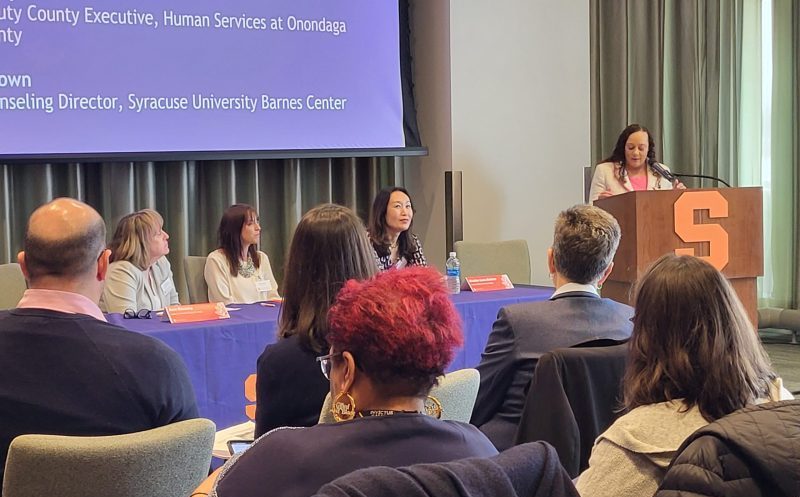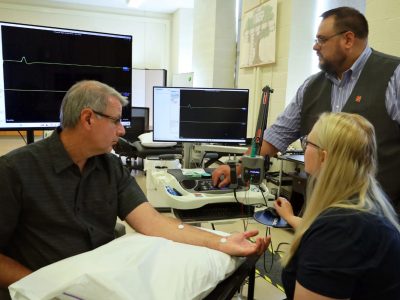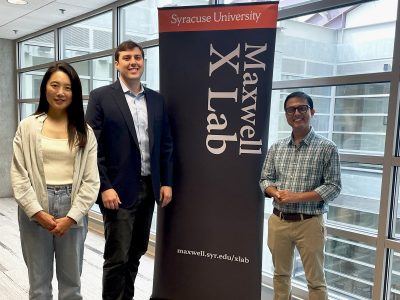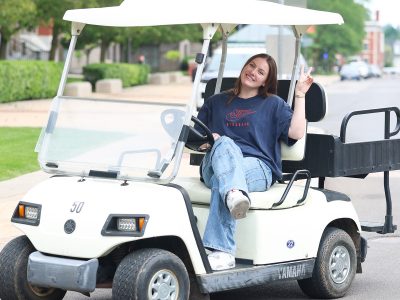Racial Wealth Gap Research Presented at MetLife Foundation-Lender Center Event
The U.S. racial wealth gap was the focus of a symposium hosted by the Lender Center for Social Justice last week.
“Interrogating the Racial Wealth Gap: Thinking Locally,” featured presentations by five faculty teams whose research is supported by 2023 MetLife Foundation grants. Projects focused on how demographics, situations and policies may create conditions that contribute to—or can help resolve—the existence of a racial wealth gap.
The term “racial wealth gap” refers to disparities in levels of accumulated wealth for individuals, families and groups and the ability of different racial and ethnic populations to access and accumulate opportunities, means of support and resources.
The symposium’s local focus is especially pertinent because Syracuse has one of the highest poverty rates (30.1%) in the U.S. and a child poverty level of close to 50%, according to Data USA and CNY Vitals. Poverty rates impact quality-of-life conditions such as accessibility to health care, housing, employment and educational opportunities, as well as economic well-being and racial and social equity.
At the symposium, researchers presented their findings and local community leaders spoke about how their organizations are addressing wealth gap issues.
Five Research Teams
“Closing the Racial Wealth Gap Through Environmental Justice and Participatory Design” findings from research of Iman Fayyad and Eliana Abu-Hamdi of the School of Architecture and Daniel Cronan of the SUNY College of Environmental Science and Forestry were presented.
The researchers reported on how air quality, heat islands, recreational facilities, public infrastructure, shelter and outdoor activity spaces affect the well-being and livelihood of neighborhoods in marginalized communities. Working with community partners and city agencies, they planned a new community space on Syracuse’s south side that features structures, landscaping and programming, with construction to begin this spring. Lender Center postdoctoral researcher J Coley also spoke on “Gentrification and Displacement in the American Rust Belt.” That presentation examined the impact of federal housing policy and gentrification on Black Americans’ ability to build wealth.
“Do Underserved and Underrepresented Communities Pay a Higher Premium in Employer-Sponsored Healthcare Coverage?” was presented by Willie Reddic and Susan Albring of the Martin J. Whitman School of Management and Patricia Crawford of the University of Rhode Island. They discovered significant socioeconomic disparities in healthcare coverage costs for underserved and underrepresented communities, especially for employer-sponsored health insurance at the state level. They reported that underserved populations, particularly those identifying as Black, allocate a higher percentage of income to employer-sponsored healthcare premiums than white and Hispanic individuals.
University Trustee Gisele Marcus ’89, a Whitman alumna, chaired that discussion session. Marcus is vice dean for the Office of Equity, Diversity and Inclusion and a professor of practice for diversity, equity and inclusion at Washington University in St. Louis.
Food Policy, Mental Health Response
“Food Policy Councils as a Vehicle to Address the Racial Wealth Gap in Food System Labor” was presented by Laura-Anne Minkoff-Zern of the David B. Falk College of Sport and Human Dynamics and Jonnell A. Robinson of the Maxwell School of Citizenship and Public Affairs.
Data from 2016-2022 surveys by The Food Policy Network at the Johns Hopkins University Center for a Livable Future, and labor questions from its 2023 survey, were analyzed to assess tensions between small-scale food business owners and worker advocates. The pair found that while food business owners may be reticent to discuss labor policy, worker advocates want to see improvements in wages and labor conditions. Though both groups have worked with American food policy councils, the researchers said progress toward racial justice for food system workers may be limited due to these divided viewpoints and differing priorities. The researchers are continuing to conduct interviews and focus groups with some of the food policy councils.
“Advancing Mental and Behavioral Health Equity through the Promotion of an Equitable Crisis Response System” was presented by Michiko Ueda-Ballmer of the Maxwell School. She created two surveys—one for Syracuse University students, the other for the general public—to measure attitudes and perceptions about the national 988 suicide and crisis lifeline, particularly among communities of color. The surveys gauge attitudes toward mental health help-seeking; barriers to help-seeking behavior; perceptions and concerns about the service; and experiences of unfair treatment based on race and other identities.
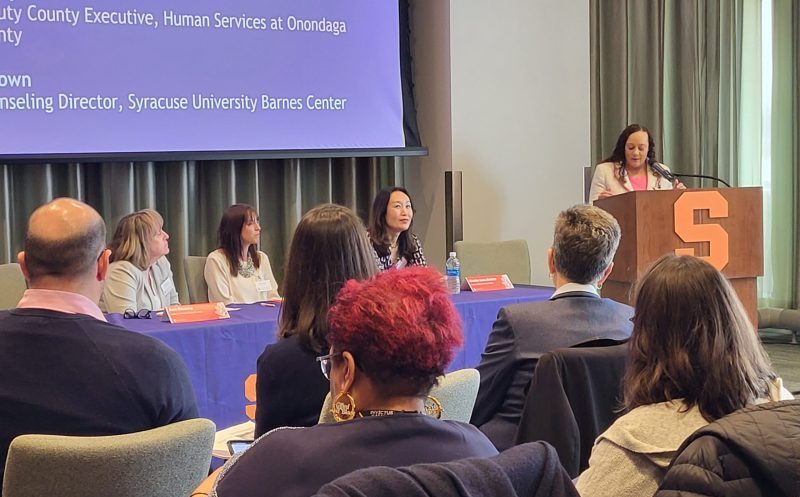
“K-12 Diversity, Equity and Inclusion (DEI) Policies and Plans” was presented by George Theoharis and Leela George of the School of Education. They discovered a spotty approach to the development and adoption of DEI policies and program integration in the New York State school districts they studied. While many had a DEI plan or have integrated DEI into their strategic goals, they found that support for the DEI work leaders are doing, and the speed and quality of those program implementations are highly varied. They also noted that several districts experienced community resistance to adopting DEI initiatives, especially around practices concerning LGBTQIA students.
Land and Wealth Loss
Thomas Shapiro, research professor of law and social policy at Brandeis University, also spoke about how the dispossession of lands from Black farmers has contributed to the racial wealth gap in the U.S. Though they collectively owned 16 million acres of land by 1910, Black farmers were dispossessed of 90% of that land over 70 years, extracting $326 billion in wealth (in today’s dollars) from that group, he said. Shapiro cited Pigford v. Glickman, a lawsuit the farmers brought against the U.S. Department of Agriculture alleging systemic racism in the allocation of farm loans and assistance. He called it “an important story…of racialized structures, policies and institutions that might be important to the work…of reparation frameworks and reparative justice.”
Community Participation
The event concluded with a community roundtable featuring local government and organizational leaders and moderated by Marcelle Haddix, associate provost for strategic initiatives. Reporting on how their groups are addressing the racial wealth gap locally were Sharon Owens, Syracuse deputy mayor; Melanie Littlejohn, president and CEO of the Central New York Community Foundation; and Robert Simmons, director of Micron Gives North America at the Micron Foundation.
This was the second annual symposium supported by MetLife Foundation’s $2.7 million award sponsoring three years of inquiry regarding racial wealth gap causes. The funds have also permitted the Lender Center to host community conversations and form new partnerships with leading national civic and academic institutions.
The next conversation, “Closing the Racial Wealth Gap: Public, Private and Philanthropic Collaborations,” takes place June 4 at the National Center for Civil and Human Rights in Atlanta.
